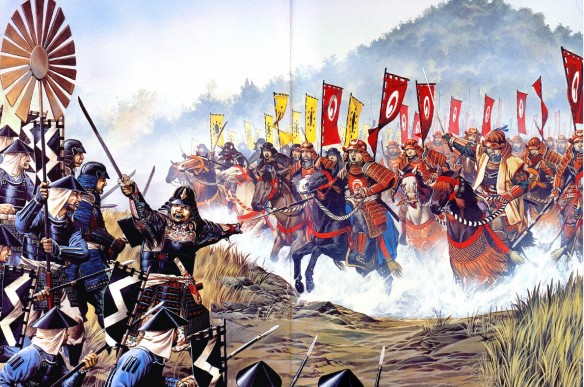The famed daimyo takeda shingen introduced the massed cavalry charge and takeda cavalry were feared throughout japan.
In the early history of Japan, the samurai were members of the court guard. In the eighth century, with the development of feudal relations, they became vassals of the larger feudal lords, the barons (daimyo) and served as their armed escort, or served the emperor directly. This is the root of their name, samurau meaning to serve.
The drawn-out feudal struggles among the great lords, which began in the twelfth century, loosened the bonds of imperial authority, but also made the samurai influential, turning them into a privileged military caste. Most were tied to the feudal lords, who did not give them land holdings but paid them in kind. The most privileged of the samurai were the bannermen (hatamoto), vassals of the shogun, militarily the strongest feudal lord in Japan, who was the country’s true ruler; the emperor was no more than a figurehead. The task of the hatamoto was to go to war for the shogun and, in times of peace, to oversee his holdings and collect taxes.
The strict code of the bushido (way of the warrior) defined the basic moral qualities of the samurai: loyalty to his master, disdain towards the lower social classes, seeking out danger, moderation, and rejection of women and money. The highest expression of the readiness to self-denial was the obligation to commit suicide in certain situations: if the master ordered it as punishment for mistakes made, in order to avoid capture, to protest against abuses of power, and to warn the master against actions which might be harmful to his reputation or interests. The bushido was founded on ancient Chinese philosophy and Buddhism.
Until the bloody civil war of 1550-1615, battles in the Japanese wars resembled individual clashes, similar to the knightly duels in Europe. The difference was that in Japan duels were often fought with large bows, both on foot and from the saddle. To shoot the bow from the saddle, the rider had to hold it in its lower third, because of its size, and to facilitate this operation, bows were made in asymmetrical shapes. They were made of laminated wood and bound with rattan. Nowadays, at the traditional archery event in the town of Kamakura, participants demonstrate the art of shooting a bow from a horse in full gallop (yabusame), used in combat by the samurai several centuries ago.
Until the thirteenth or fourteenth century, archery combat was the principal form of horseback fighting; swordplay was marginal. When fighting on horseback, the samurai used a long, single-handed sword (tachi). As sword combat became more important, fighting on foot increased, and the samurai used a shorter, two-handed sword (katana).
During the civil war, large armies were raised which fought rationally and purposefully; there was less and less space for the traditional forms of combat. One of the most powerful warlords, Takeda Shingen (1521-73), organized an effective cavalry force which charged the enemy with spears and swords, and was also successful in hand-to-hand combat.
